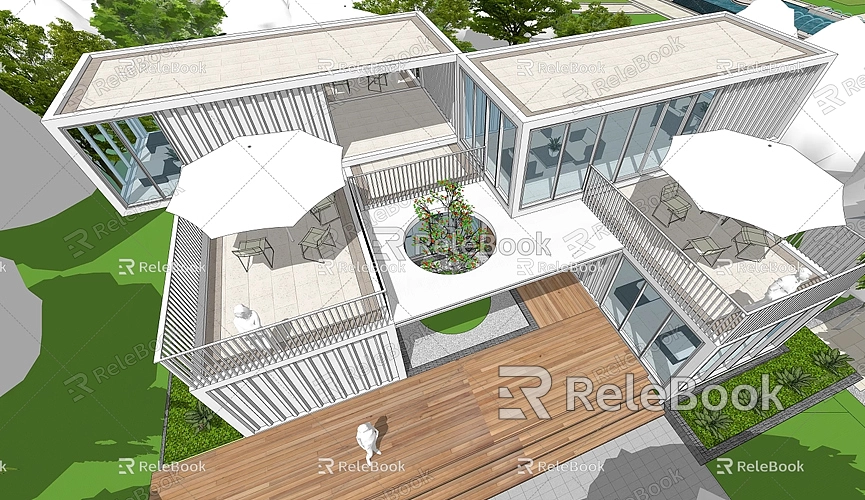How to Add Models to SketchUp Online
In the fields of architecture, interior design, and landscape design, SketchUp has long been a highly regarded 3D modeling software. Whether you're a beginner or an experienced professional, SketchUp enables users to quickly create and modify 3D models. With the release of SketchUp Online, users can now design from anywhere, without the need to download and install cumbersome software. So, how do you add 3D models in SketchUp Online? That’s what we’re going to discuss today.
Understanding the Basic Interface of SketchUp Online
Before adding models, it's essential to familiarize yourself with the basic interface of SketchUp Online. Compared to the desktop version, the online interface is more streamlined yet still powerful. Users can design directly in their browsers without worrying about computer specifications or storage space.

When you open SketchUp Online, you'll see an intuitive toolbar. The left side features commonly used tools, such as the Select Tool, Move Tool, and Push/Pull Tool. The top menu bar helps you save, import, and export projects. The central area is the workspace, where you can perform all your modeling and design tasks.
How to Import Local Models
Importing local models into SketchUp Online is very straightforward. Assuming you've already created or downloaded a model file on your computer, you can add it to SketchUp Online by following these steps:
1. Open a Project: After accessing SketchUp Online, start by creating a new project or opening an existing one.
2. Click the File Option: Locate and click on the "File" option in the top toolbar, then select "Import."
3. Choose File Format: SketchUp Online supports various file formats, including .skp, .dwg, and .dxf files. If you're importing models from other software, ensure the file format is compatible with SketchUp.
4. Upload the File: Click the "Select File" button, find the model file you want to upload, and import it. Once the file is imported, you’ll see the 3D model added to the workspace.
Using the 3D Model Warehouse

If you don’t want to create models from scratch or need to find ready-made 3D models quickly, SketchUp’s 3D Warehouse is an incredibly useful resource. It contains millions of free 3D models shared by users from around the world, which you can directly download and add to your projects.
Here’s how to use the 3D Warehouse:
1. Open the 3D Warehouse: In SketchUp Online, click the "3D Warehouse" icon at the top right corner. This will open the model library interface.
2. Search for Models: Enter keywords for the models you need in the search bar, such as “sofa,” “trees,” or “buildings.” You will see a large number of relevant results.
3. Select and Download a Model: Once you find a suitable model, click on it and select “Download.” SketchUp will automatically add the model to your workspace, where you can adjust and edit it.
The biggest advantage of the 3D Warehouse is its convenience, especially for users who aren't skilled in modeling. Using the 3D Warehouse can quickly enhance the completeness of your projects. However, sometimes the models in the library may not fully meet your needs, in which case you might need to source higher-quality 3D models and textures from elsewhere.
Importing External 3D Resources
Besides the built-in 3D Warehouse, you can also download high-quality 3D models from other websites and import them into SketchUp Online. For example, if you need high-quality 3D textures and HDRIs while creating models and virtual scenes, you can download them for free from [Relebook's 3D Texture Download Site](https://textures.relebook.com/). If you need beautiful 3D models, you can find them at [Relebook's 3D Model Download Site](https://3dmodels.relebook.com/), where Relebook offers a vast array of premium 3D resources.
External 3D models are often more detailed and complex than those provided by SketchUp, especially when creating high-quality scenes. The process of importing these external resources is similar to importing local models—just make sure the file formats are compatible.
Adjusting the Size and Position of Imported Models
Whether you’re downloading models from the 3D Warehouse or importing them from external websites, the size and position of the models might not perfectly match your project requirements. Therefore, you often need to make adjustments after adding the models. SketchUp provides various tools to help you quickly adjust the size, position, and angle of the models.
1. Select Tool: Start by clicking on the model with the Select Tool to make sure it’s selected.
2. Scale Tool: Click the Scale Tool in the toolbar. You can adjust the size of the model by dragging its corner points. Keyboard shortcuts can help you control the scaling ratio more precisely.
3. Move Tool: Use the Move Tool to place the model in the correct position. When moving models in 3D space, check their position from different angles to ensure accuracy.
4. Rotate Tool: If the imported model is not aligned correctly, you can use the Rotate Tool to adjust its angle. You can manually set the rotation angle or enter specific values for precise control.
These adjustment tools ensure that imported models fit seamlessly with the overall style and scale of your project.
Optimizing SketchUp Online Performance
When working with complex models in SketchUp Online, you may experience performance slowdowns, especially if there are many models or if the files are large. Here are a few tips to optimize performance:
1. Hide Unnecessary Models: If you only need to work on a specific part of the scene, temporarily hiding other models can significantly improve system speed.
2. Reduce Graphics Display Quality: In SketchUp Online settings, you can adjust the graphic display quality. Choosing a lower display quality can enhance performance, especially when working on low-spec devices.
3. Simplify Model Details: If an imported model is too complex, consider simplifying it by reducing the number of polygons, removing unnecessary faces, or using fewer textures.
These methods will not only improve SketchUp Online's performance but also make it easier to handle large projects.
Saving and Exporting Projects
After adding and adjusting your models, don’t forget to save your project. SketchUp Online supports auto-save, but to ensure your data isn’t lost, it’s best to manually save a recent version. You can save projects to Trimble Connect's cloud storage or export them as local files. SketchUp Online supports multiple export formats, including .skp, .dwg, and .dxf, making it easier to continue editing and using the models in other software.
With SketchUp Online, you can easily work on 3D modeling projects online. Whether you’re importing local models, downloading resources from the 3D Warehouse, or using external high-quality 3D resources, the process of adding models is simple and efficient. If you need high-quality 3D textures and HDRIs while creating models and virtual scenes, you can download them for free from [Relebook's 3D Texture Download Site](https://textures.relebook.com/). For premium 3D models, visit [Relebook's 3D Model Download Site](https://3dmodels.relebook.com/), where a vast selection of top-quality 3D resources is available.
By making good use of these resources and mastering the SketchUp Online tools, you can complete your design projects faster and more efficiently. In your future creations, try leveraging these tips to enhance your modeling experience.

